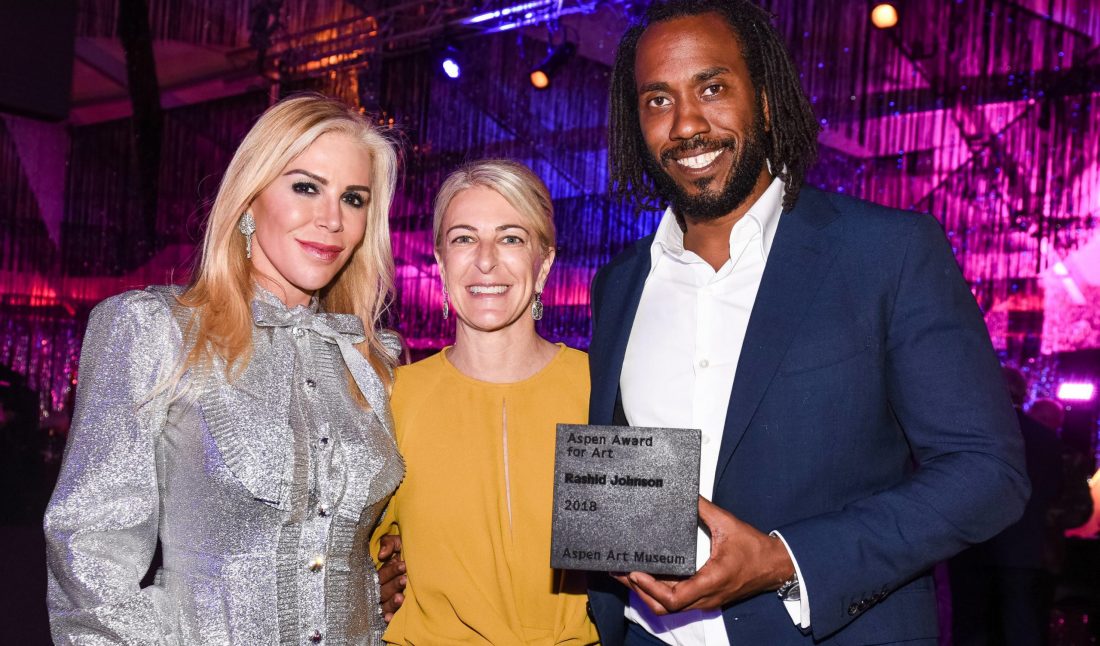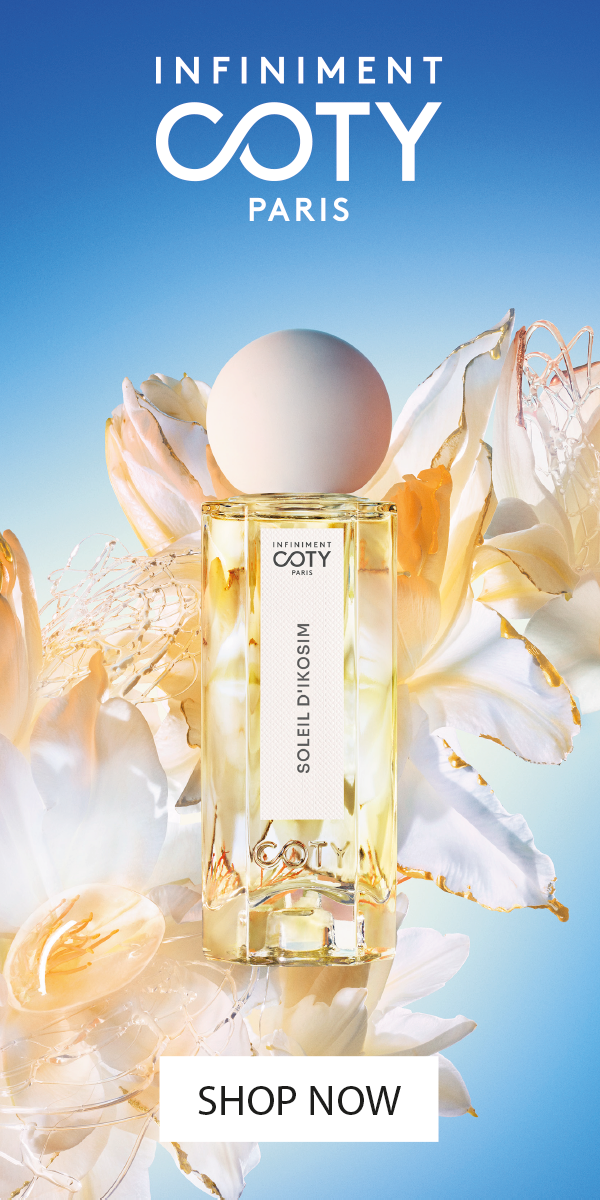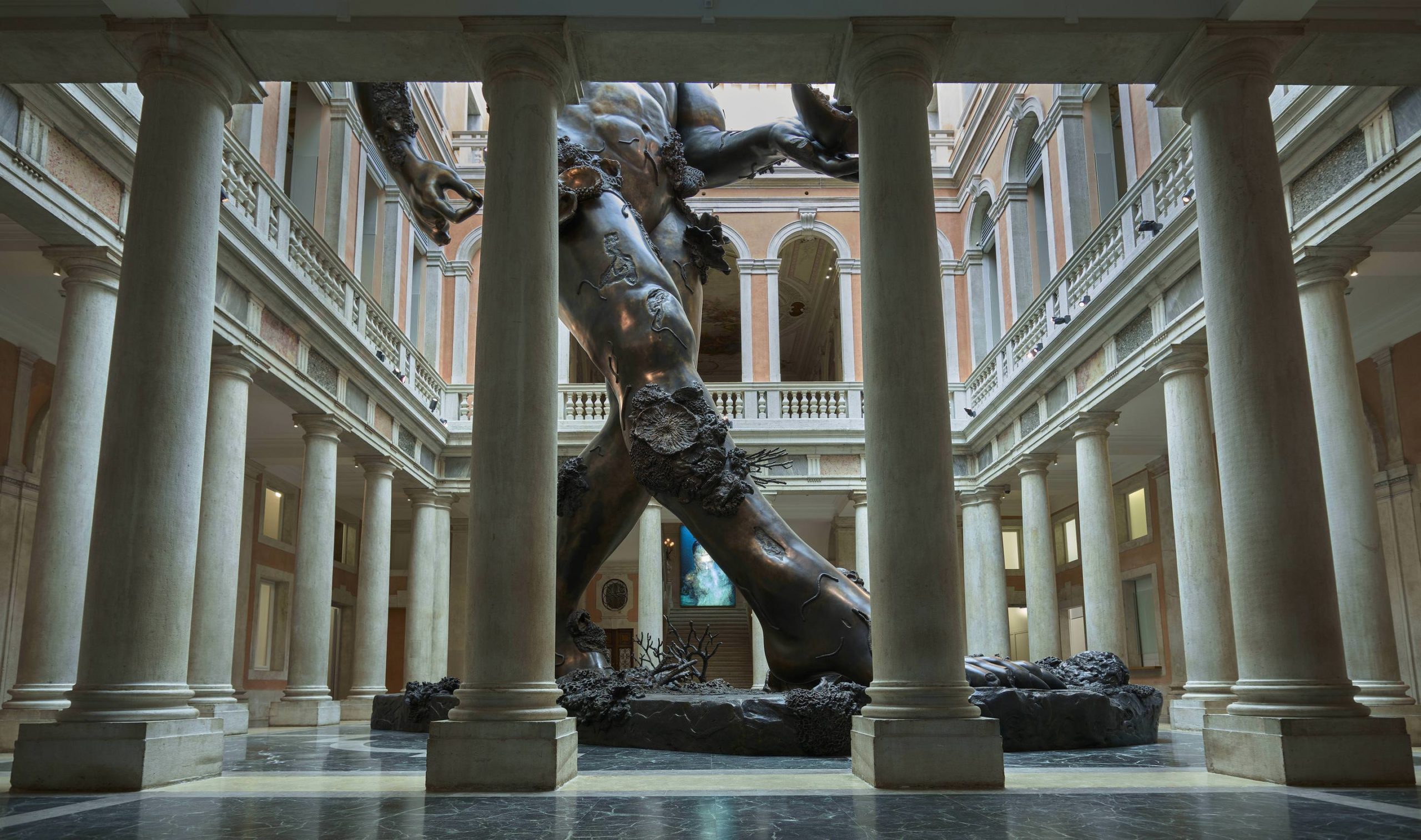On Friday, August 3, the Aspen Art Museum (AAM) hosted over 500 art world insiders at the 14th annual ArtCrush auction benefit, raising over $2.5 million in funding. Each year, the event honors an artist with the Aspen Award for Art. This year, it was New York-based artist Rashid Johnson who was acknowledged for his dedication and patronage in the industry.
Johnson has been a guest of ArtCrush for several years, both donating works and showing support. This year, he furthered that relationship with the city and the museum by accepting the honor and donating a large work to the auction—one from his “Escape” series that he had previously intended to keep for himself.
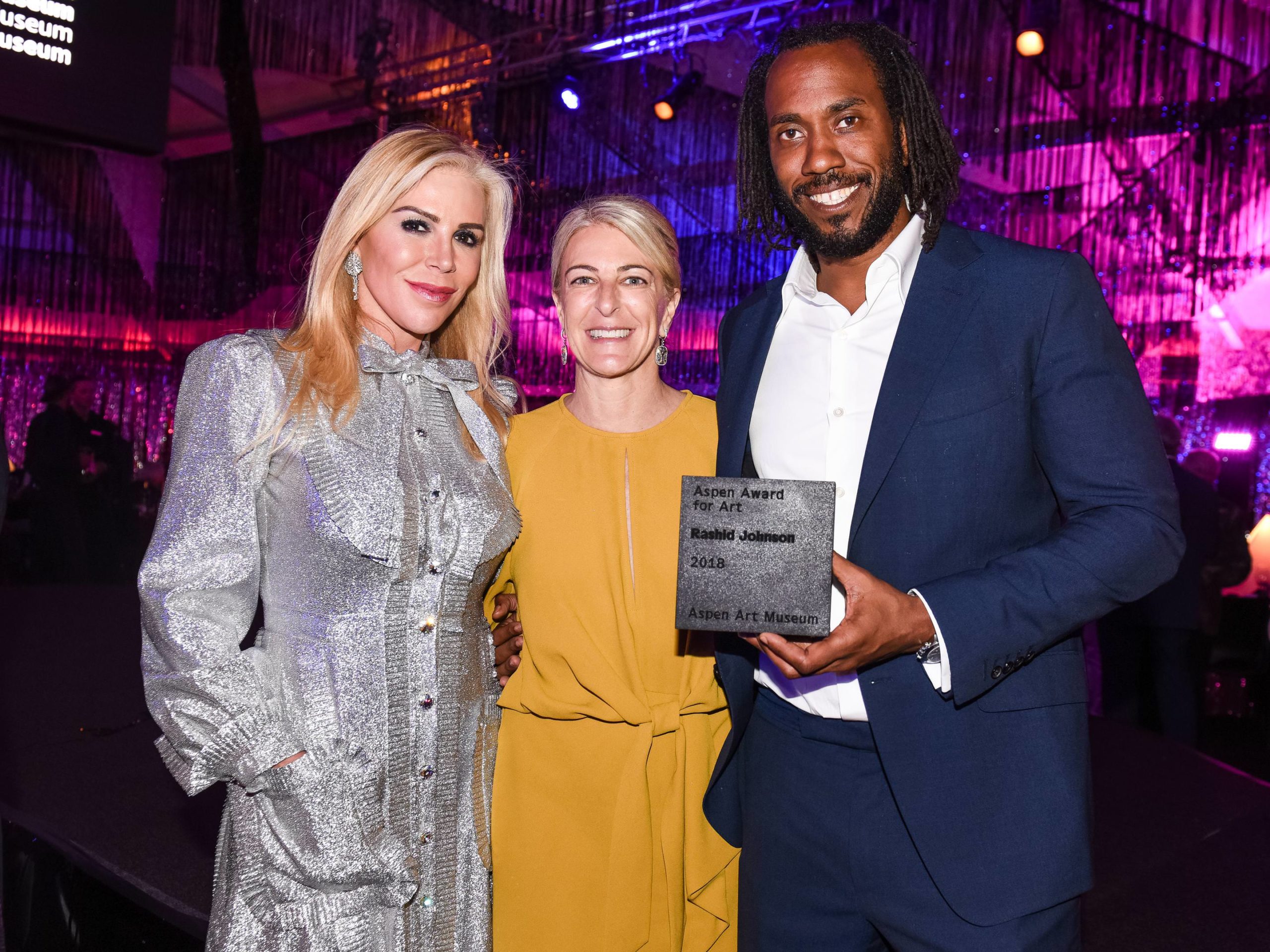 Aspen Art Museum 2018: ArtCrush Gala.
Aspen Art Museum 2018: ArtCrush Gala.Amy Phelan, Heidi Zuckerman, Rashid Johnson.
Photo by Owen Kolasinksi for BFA.
Courtesy of the Aspen Art Museum.
Leading up to the festive ArtCrush night, Johnson also participated in WineCrush at John and Amy Phelan’s home, PreviewCrush at Baldwin Gallery and Casterline | Goodman, and a talk at AAM hosted by CEO and Director Heidi Zuckerman.
Amid his busy schedule, we caught up with Johnson at Hotel Jerome to talk about the award, creating a journey with solution-based art, and never saying never.
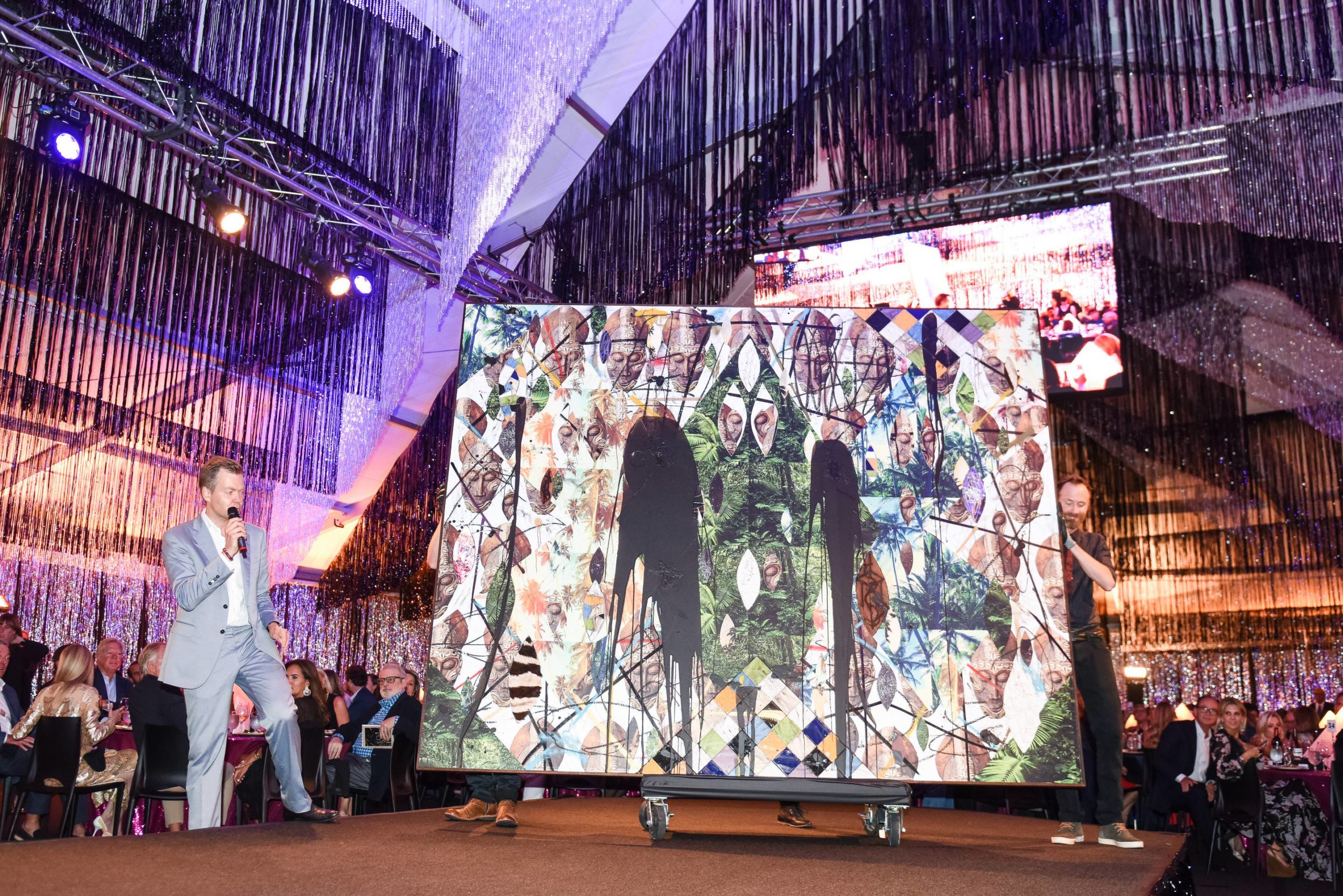 Aspen Art Museum 2018: ArtCrush Gala.
Aspen Art Museum 2018: ArtCrush Gala.Oliver Barker, Rashid Johnson.
Photo by Owen Kolasinksi for BFA.
Courtesy of the Aspen Art Museum.
WHITEWALL: Why is the Aspen Award for Art special for you?
RASHID JOHNSON: It’s really interesting. Being honored, you always wonder, “Wow. What exactly did I accomplish to earn this?” For me, based on some of the other artists who have been honored, those who have been here to witness them being honored, and those who I’ve been around who have been honored (like Lawrence Weiner, who I think has had an amazing career), just being in a similar group with those kinds of artists and people with that kind of talent and sincerity is an honor to be a part of.
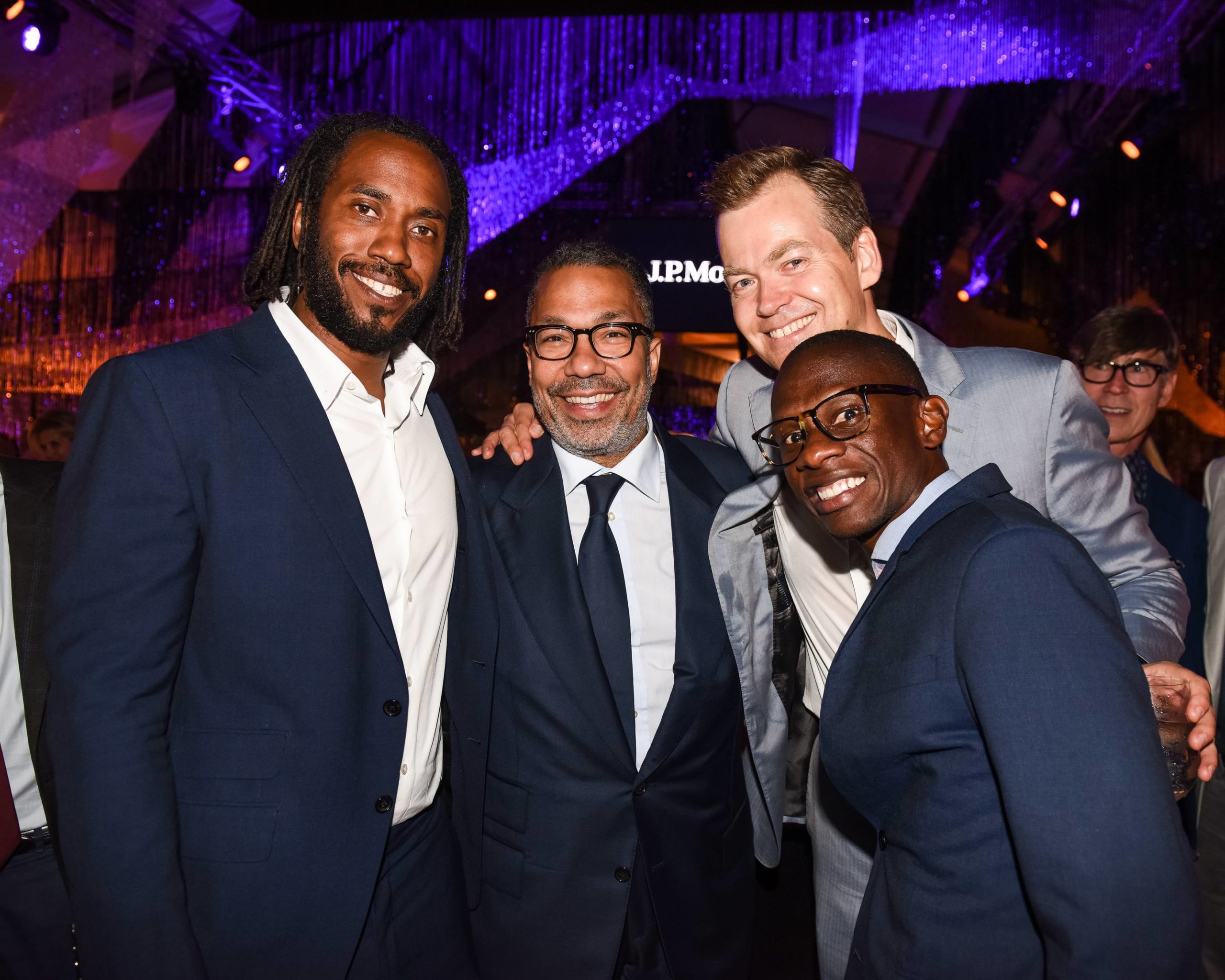 Aspen Art Museum 2018: ArtCrush Gala.
Aspen Art Museum 2018: ArtCrush Gala.Rashid Johnson, Valentino Carlotti, Oliver Barker, Troy Carter.
Photo by Owen Kolasinksi for BFA.
Courtesy of the Aspen Art Museum.
For me, it’s more about the context. It’s not about getting an award, it’s about who’s giving it to you and who’s gotten it in the past. I think based on the quality of people that have been around the Aspen Art Museum, the quality of their program, Heidi (who I think is a really exceptional director and a great advocate for artists), and the people who have received it, makes it an attractive thing to be a part of.
WW: In 2011, you donated a work to the ArtCrush auction for the first time. What was that piece like?
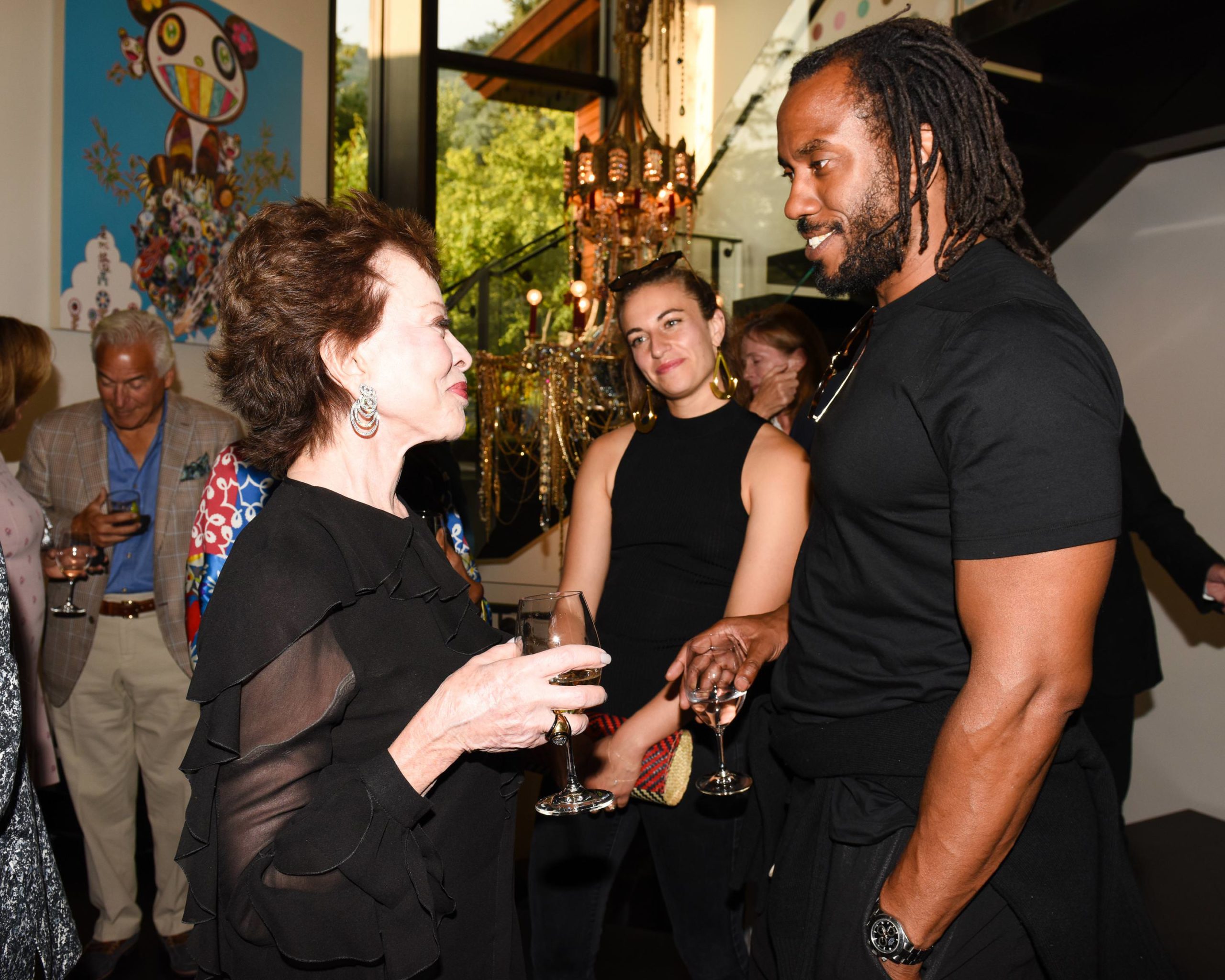 WineCrush 2018.
WineCrush 2018.Nancy Magoon, Rashid Johnson.
Photo by Owen Kolasinksi for BFA.
Courtesy of the Aspen Art Museum.
RJ: I’m pretty confident I showed a branded wood flooring work, which is a body of work that I was really proud of and excited about at the time, and still am. I don’t make them any longer, but for me, I learned a lot from that body of work around the idea of how you penetrate and dig into a surface. This idea of an excavation at the time was really exciting and it still is in a lot of ways, and the way it affects my practice. Even leading up to the work that I donated this year, there are some elements that I think are quite in line with that work that I donated in 2011.
WW: What is the piece like that you’re donating to this week’s auction?
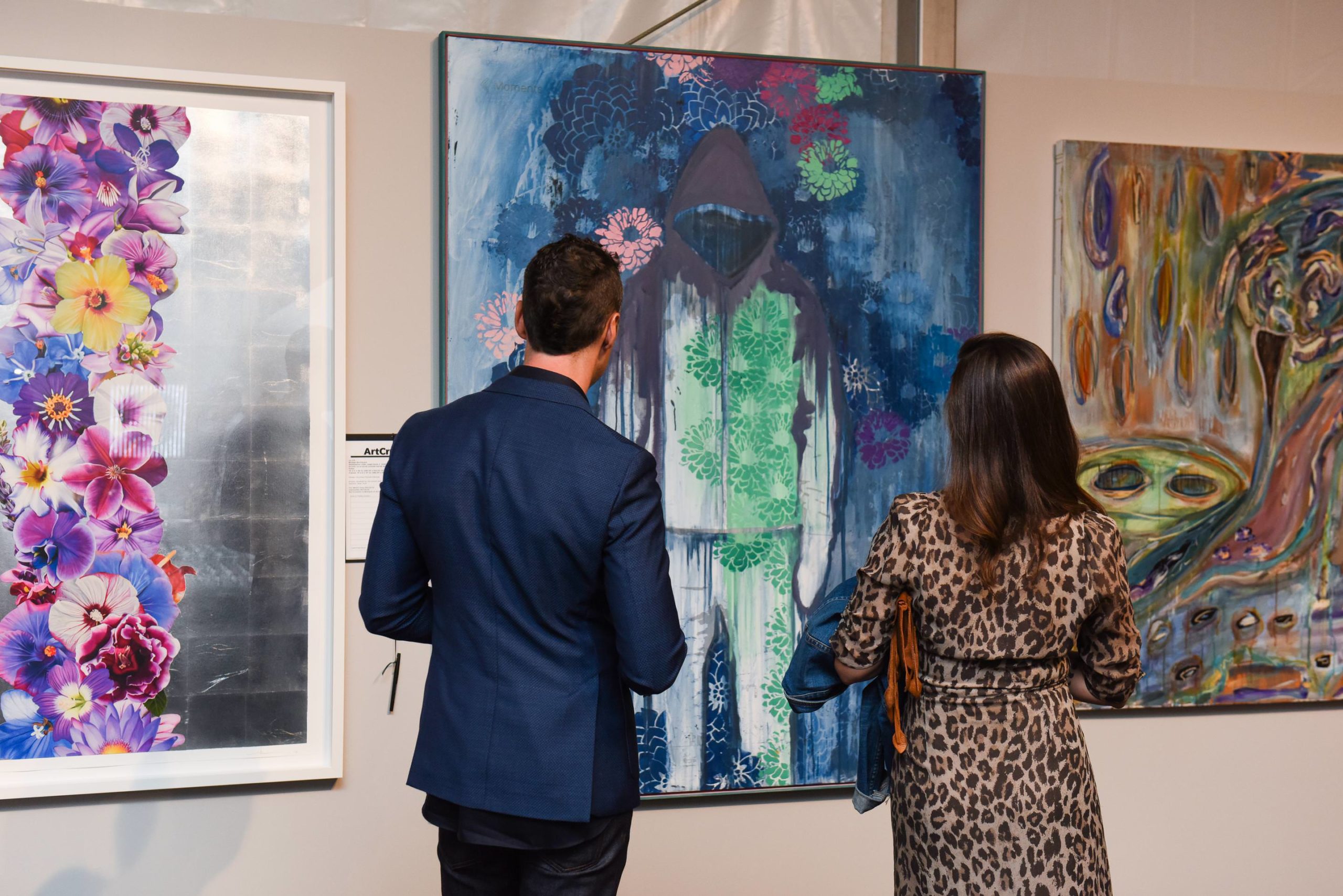 Aspen Art Museum 2018: ArtCrush Gala.
Aspen Art Museum 2018: ArtCrush Gala.Courtesy of the Aspen Art Museum.
RJ: This year’s piece is a newer body of work and comes from a series that I’ve been working on over the past few years—collage works, playing with images, adding them together, and then also connecting them to tile and other material that I’ve used in the past. I’ve been working on them for a few years, but they were shown most recently at an exhibition with David Kordansky Gallery in Los Angeles.
This work in particular is one that I held back from that exhibition, that I intended to keep for myself. I knew that I had the Aspen benefit coming, but I didn’t think this was going to be the work I would donate. But I’m excited to give something that I think was really subsequent to the practice, as far as scale, labor, intensity, and my own investment. It’s a work that I’m quite proud of and I hope that it raises plenty of money for the institution. That was really my goal.
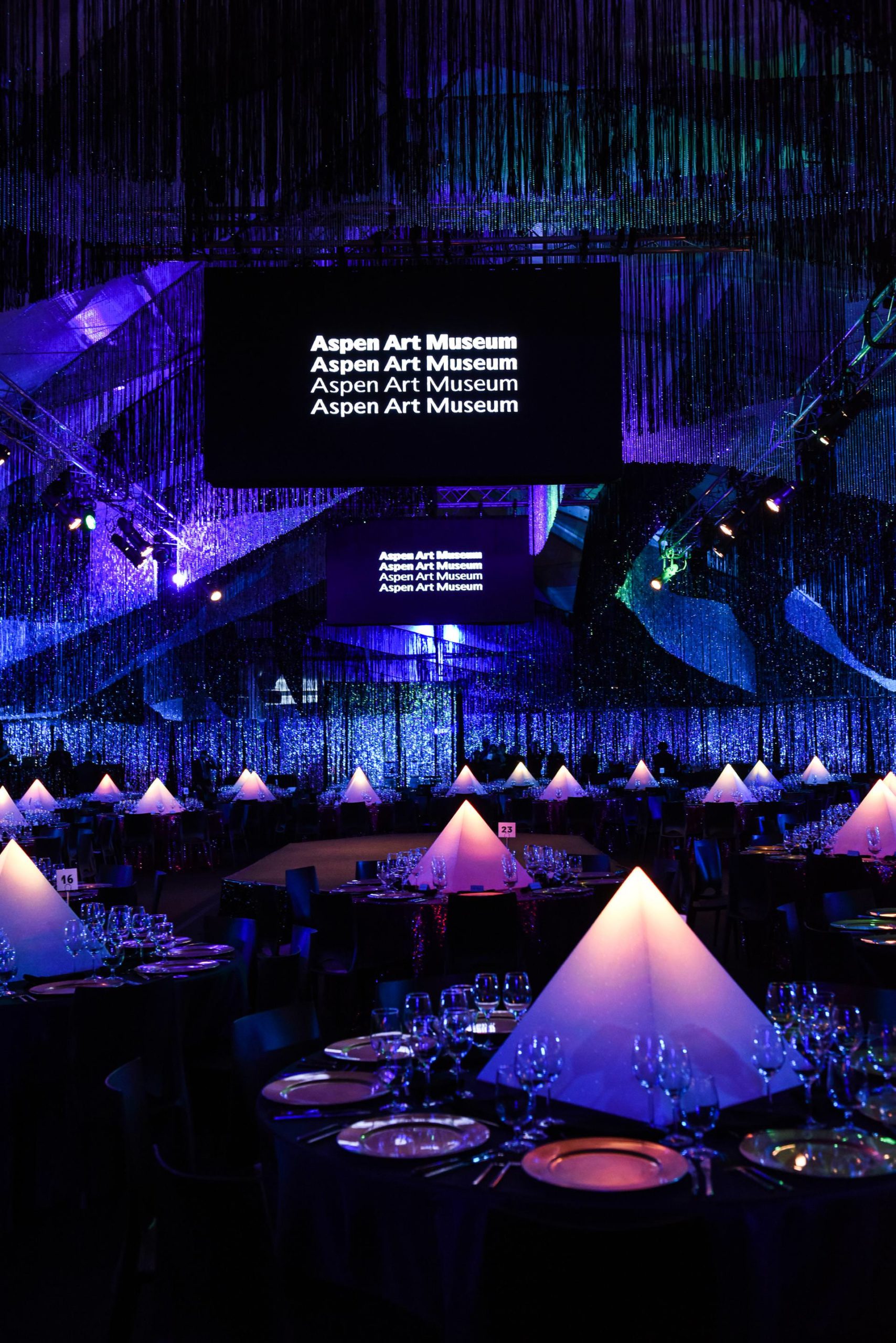 Aspen Art Museum 2018: ArtCrush Gala.
Aspen Art Museum 2018: ArtCrush Gala.Courtesy of the Aspen Art Museum.
WW: Your work raises plenty of questions and feels open to interpretation. Does this body of work have a particular message?
RJ: I stay away from messaging and metaphor in the work. There’s quite a bit of antecedent, and people who are familiar with my practice are familiar with some of the signifiers that I’ve employed in the past. I think there’s a road map to kind of considering why and how a work like this was made and what it can begin to suggest.
Starting from the title, Escape collage, this idea of escape and escapism has been really effective strategies for me to discuss the psychological condition of being a man in America, a black male in America, a person with anxiety in America, a person born into a middle-class home in America.
For me, this idea of escape really is effective to discuss so many different things. I think that is something that could be interpreted into any person’s understanding of personal conditions or how you see the world.
I’m using quite a bit of disparate imagery. You see a lot of greenery and plants and this idea of the beach and a more iconic space or a space that you would want to get to, which I think there’s a kind of almost dystopic intervention that happens somewhere in that world. They’re obviously very much collage, so you see all of this different kind of material, and you see the kind of language that I’ve employed with tile and the idea of the domestic and domesticity.
You see soap and wax and this idea of the opportunity to clean oneself—the agency that comes with cleanliness and the opportunity to cleanse. Especially with people who have more sensitive skin, black soap is employed as a tool for people who have a certain amount of sensitivity. If you wanted to use that as a metaphor, you could talk about the idea of sensitivity. There’s what’s happening with the imagery, what’s happening with the shape and the repetition of the shape. There’s also this idea of raining or teardrops or eyes—focusing or looking.
I think that there’s a lot of different direction that you could take. I don’t think that there’s one specific way to interpret it in a sort of didactic fashion. But I think there’s enough there to start a journey, and I think the best artwork should start a journey.
WW: Your upcoming exhibition at the AAM in June 2019 will coincide with an exhibition in Mexico City at the Tamayo Museum. The two exhibitions will showcase mostly new works—some sculptural pieces, and a dance work, as well as a video. Can you tell us more about that?
RJ: I’ve become really interested in performance in the way that institutions can house performers, and the kind of collaborative nature of working with artists in different mediums. In this particular case, there’s something around ballet—that kind of sincerity and poetry that lives in those kinds of movements—that I’ve been interested in exploring in relation to other things that I’ve done in the past (like The New Black Yoga and Samuel in Space, which are smaller projects that a lot of people are less familiar with). This actually brings those to life and animates them in the space as well as having a film component, so I’m excited about that.
I’m really thinking about these collages. Not totally dissimilar to what I’ll be donating to the auction, but the next iteration of those kind of combined signifiers. And then there’s a sculptural element that I’m really starting to work through that would have a kind of robust, playful, sculptural element, but I’m not ready to talk about that yet.
WW: Heidi Zuckerman also mentioned to us that the dance performance was going to be recorded and the videos were going to be shown at the Tamayo Museum in Mexico City. What do you envision this work saying to the local community in Mexico City?
RJ: Mexico City is a beautiful place. The energy there is amazing. It’s incredibly cosmopolitan, people are so fashionable, the food scene is amazing, and there’s really a rigorous and serious art scene that’s built up there. In all honesty, it’s been there for quite a while, but a lot of us have come to recognize it more recently. There’s an avant-garde spirit there and I think a lot of my work shares a kinship to artists who are working there currently, and artists who started their careers in that scene—kind of a conceptual rigor, an understanding of material and performance.
I think that my ideas and the way that my work functions isn’t necessarily going to be foreign to that place. It’s rare that my work is foreign because it genuinely employs so many western strategies for art practice that I’ve then kind of hybridized and hijacked and placed into a different discourse. And maybe that starts to produce language that people think is different. I hope that’s the result.
But having said that, all of the tools, all of the ways of working, and all of the philosophies are born of things that any sophisticated or thoughtful viewer of art can begin to interpret and deconstruct. So I don’t think that my work lives as a foreign invasion in any place. I think it lives as part of the conversation that a lot of contemporary artists are having, but it’s just had from my perspective.
WW: Do you remember your first-ever piece of work, or something that you would consider your first piece of work?
RJ: There’s a photograph that I made that I was really proud of in my freshman year of college. I guess it’s right around when I started to consider that what I was making would potentially be artwork. I made a photograph of a friend from the backseat of his car looking into the light of a gas station. I developed that image and really thought that it was an artwork.
WW: Perceiving something as artwork is a personal choice, and sometimes an informed one. As a father, are you having conversations with your son yet about art? Is there anything that you’re particularly passionate about him understanding?
RJ: I like to expose him to as much as I can. I never really thought much about teaching him about the art world. That’s a thing I’m not massively invested in him understanding, but how solution-based art can be is important. It can so often be this critical attempt to express oneself, and I think for children, that can be an incredible thing to learn.
Art can be this opportunity for self-expression, and it can be narrative and tell your story, but at the same time, it doesn’t have to do any of that shit. It can be whatever you really want it to be. But I like to keep it open for him to be able to understand that he can interpret things and he has agency as a viewer to think whatever he wants.
WW: What’s in your home? Do you collect? Do you have any particular pieces that make you happy when you look at them?
RJ: I do. My wife and I collect. David Cressey ceramics. He’s a mid-century, West Coast ceramicist. And Robert Maxwell. We have a beautiful painting of Robert Colescott’s—a painter who I think has been getting a lot more attention recently. We’ve had the work for years and I’ve been a fan for quite a while.
I’ve also traded with lots of friends. I do sometimes buy work by younger artists. I see it as an opportunity to kind of be supportive of them, so there’s quite a few things by younger artists that we’ve been supportive of. Some of the art heroes that I have, we have works of. So my house is filled with stuff. I do like art.
WW: You began working in photography and have moved toward working with many different mediums, such as sculpture, painting, and music. Tell us why you initially began working with photography.
RJ: I started working in photography because in the ‘90s that’s where the interesting artists were. It felt like a radical medium. There was mechanical reproduction and the image and the idea of optics and representation. Photography was representative of the new figuration in a lot of ways. It was conceptually relevant and engaging and photography and video were where some of the more rigorous conceptually-invested artists were working. I was like, “Oh, I want to be around those guys.”
More or less that’s changed in a lot of ways. A lot of other mediums have started to regain the mantle of the avant-garde, so my work has kind of floated through all of the mediums because I do whatever I need to do to make something that I think is the most engaging and interesting at any given moment.
WW: And it’s going to change with the ebb and flow of new mediums, and the of the rise of technology. We didn’t have VR or AR until recently, so you just never know, right?
RJ: I’m really a luddite. I’m not particularly strong with technology so it would be a stretch for me to get into that space. And I’m still very married to my hands, and how things are created that way. But, I mean, I’m never saying never.







